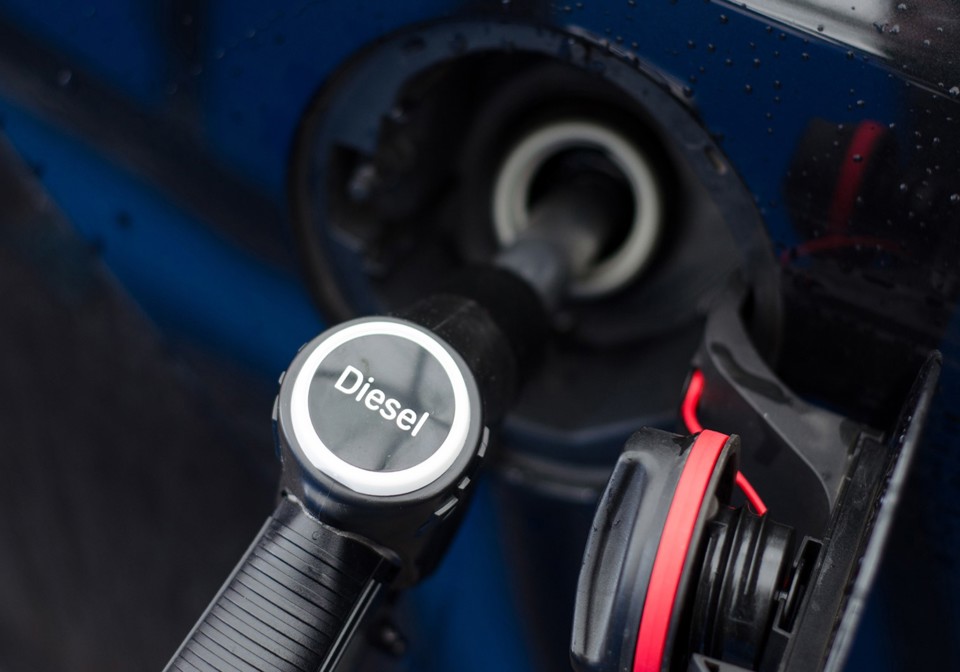Fleets are taking delivery of the first RDE2 diesel cars, cutting vehicle excise duty (VED) and company car tax, with manufacturers promising that more models will follow.
Mercedes-Benz stole a march late last year, when it added two new diesel engines to the A-Class range – the A 200d and the A 220d – which met stricter emissions limits, well before they become the legal requirement.
The new units have been tested to the RDE2 standard, meaning company car drivers will benefit from tax savings thanks to the removal of the 4% benefit-in-kind (BIK) tax diesel surcharge.
Fleets will also benefit from not having to pay the higher first-year rate of VED on new diesel cars not meeting the RDE2 standard.
The German carmaker says it now has eight RDE2-compliant cars available to order: A200d, A220d (both available as saloon or hatch), B200d, B220d, GLE 350d and GLE 400d. The first deliveries were made in February.
Jaguar Land Rover (JLR) has also been quick out of the blocks, announcing in January that the all-new XF 2.0-litre diesel 163PS and 180PS rear-wheel drive variants had been certified as RDE2-compliant (fleetnews.co.uk, January 30).
It says this could save 40% taxpayers up to £2,304 in company car tax over three years compared with models which are subject to the 4% diesel surcharge.
JLR subsequently announced that the revised XE would also be available with an RDE2-compliant 180PS diesel engine, as well as 163PS and 180PS XF Sportbrake models and the new 150PS Evoque.
The manufacturer told Fleet News that further announcements on RDE2-compliant cars are “imminent” and deliveries of the first tax-busting models would be made by the end of this month.
It says its latest diesel engines offer approximately 25% better fuel economy than their petrol equivalents, produce around 15% less CO2 and emit around the same amount of NOx.
Rawdon Glover, managing director of JLR UK, attributed its success to “significant investment” in advanced engine technology.
“These new diesel engines meet the demanding target, set by the latest European standards, well ahead of schedule,” he said. “The test results reflect their performance in real-world driving conditions.”
BMW told Fleet News that the new 1 Series will be its first model that is classified as RDE2. A spokesman said: “We will introduce RDE2 technology into the BMW range from the middle of this year, with the first customer deliveries in Q3.
“There will be a staggered roll-out of this technology across the range but the full model range will, of course, be compliant ahead of the required deadline.”
Vauxhall is also advanced with its plans, with the new Astra, due for launch this summer (first deliveries Q4), the first of its RDE2-compliant models. “Then it comes model by model,” said the company.
However, Audi admitted it was still in the “preparatory phase” after dealing with re-homologation under the Worldwide harmonised Light vehicle Test Procedure (WLTP).
A spokesman said: “We continue to work at full speed on this to close the remaining gaps in our product range and to minimise delays.”
CHANGING STANDARDS
The hope is these latest diesel engines could offer some respite to the beleaguered fuel, turning the tide on the anti-diesel rhetoric.
However, EU law-makers, who decided to subdivide the Euro 6 standard, rather than call RDE2-compliant cars Euro 7, have not helped that cause.
When the new vehicle emissions test, WLTP, replaced NEDC for all new type approvals in September 2017, the Real Driving Emissions (RDE) test was also introduced to offer an on-the-road measurement.
The limits for emissions remained the same but the testing regime changed and was reflected in a new standard – Euro 6b became Euro 6c.
Under the RDE test, the car is fitted with a portable emission measuring system (PEMS) before being driven for 90 minutes on public roads in different conditions, with both uphill and downhill driving, and a mix of urban and rural roads and motorways.
It is being introduced in two stages, the step 1 test – RDE1 – became compulsory for all new type approvals from September 1, 2017, when WLTP was also introduced.
RDE1 will become mandatory for all new registrations from September 1.
WLTP testing, which takes place in the lab, has been mandatory for all new registrations since September 2018, with diesel cars having to meet the NOx limit of 80mg/km and petrol 60mg/km, with cars achieving the limit labelled Euro 6c.
New type approvals, however, have also had to meet the limits on-the-road from September 2017.
The EU has cut manufacturers some initial slack, allowing for a margin of error two times the actual limit. Cars achieving RDE1 are classified as Euro 6d-temp.
However, the rules will begin tightening from January 2020, starting with new type approvals.
This next stage, RDE step two (RDE2), is the measure now being achieved early by some manufacturers, giving fleets and company car drivers the benefit of a tax cut first announced in Budget 2017.
The NOx limit for the RDE2 standard is up to 1.43 times the Euro 6 lab limit of 80mg/km for diesel and 60mg/km for petrol. Cars achieving this limit are labelled Euro 6d.
RDE2 will apply to all new registrations from January 1, 2021, before the margin for error – the conformity factor – will be removed by 2023.
LEGAL ACTION
Brexit will not diminish the emissions rules either, given the Government has said they will apply when the UK leaves the EU.
The rules have been called into question in the courts, however, with three cities – Brussels, Madrid and Paris – successfully challenging the provision allowing on-the-road emission limits to vary from those required in the laboratory (fleetnews.co.uk, December 14, 2018).
The European Court of Justice ruled in their favour, saying that the European Commission (EC) had no power to weaken the emission limits.
The ruling meant the Commission needed to amend the RDE regulation to ensure that diesel vehicles actually emit less than 80mg/km during the one-the-road test.
The EC subsequently lodged an appeal against the ruling and is also preparing new legislation that will have the same effect as the law declared illegal by the courts in December.
Elzbieta Bienkowska, European Commissioner for industry, says that if the new legislation is adopted in time, the commission will withdraw the appeal (fleetnews.co.uk, February 21).
PETROL PARITY
Andy Eastlake, managing director of the Low Carbon Vehicle Partnership (LowCVP), says the “overriding aim” must be to accelerate the drive to “truly, low pollution vehicles” and to rapidly increase the number of zero emission miles driven.
However, he told Fleet News: “While combustion fuels still predominate, we need to use all the tools in the box to deliver lower CO2 and cleaner air, and the efficiency of diesel engines should be captured where possible.
“The latest diesels must, and with RDE2 can now be shown to, deliver emissions as low as petrol.”
Indeed, tests conducted by German automobile club ADAC on some of the latest models, not officially classified as RDE2, suggest they are as clean as their petrol counterparts.
The conformity factor for RDE2 gives an actual on-the-road limit of 114mg/km for diesel and 86mg/km for petrol.
Nearly all the cars tested by ADAC emitted less than 50mg/km (fleetnews.co.uk, February 25).
The Volkswagen Golf 1.6 TDI SCR performed exactly the same as its petrol counterpart, emitting 14mg/km of NOx.
ADAC performed the tests using a portable emissions measurement device (PEMS), in the same way as the official test.
Erik Jonnaert, secretary general of the ACEA, the European trade association for carmakers, believes modern diesel cars can play a strong role in helping cities move towards compliance with air quality targets.
“It is important we stop demonising diesel technology as a whole,” he said. “Instead, we need to differentiate between the old diesel fleet and the latest generation of vehicles.”
Should we trust them this time? RDE2 and the diesel dilemma
 Nick Molden, Co-Founder and CEO of Emissions Analytics, Co-Founder and Director of the AIR Alliance
Nick Molden, Co-Founder and CEO of Emissions Analytics, Co-Founder and Director of the AIR Alliance
The second stage of Real Driving Emissions testing (RDE2) calls for no more than 114 mg/km of nitrogen oxides (NOx) over a wide envelope of real-world driving conditions. This requires an impressive clean emissions performance from diesel vehicles. But should we trust the system this time?
We can be more confident now, yes. RDE2 is very similar to what has been in place in the USA for more than 10 years. The US test is easier, but the limit is lower and the engineering task overall is similar.
RDE2 vehicles are typically delivering emissions in the 20-40mg/km range on the Emissions Analytics’ test cycle, compared with the average of pre-RDE diesels in Europe of around 400mg/km. So, at least an order of magnitude reduction.
Further, the imminent introduction of in-service conformity testing, which can be carried out by third parties, will make it risky to cheat, meaning confidence in RDE2 results should be higher.
Good though they are, these RDE2 vehicles will not be enough to solve urban air quality problems.
Why? At the same time as these RDE2 vehicles are on sale, for the next six months there will still be new diesels available legally emitting 400mg/km and more – all labelled Euro 6.
As Euro 6 has been in place since 2014, the number of pre-RDE Euro 6 diesels on the road will dwarf the number of RDE2 vehicles for years to come. Even some of the early RDE1 vehicles skate close to the emissions limit and will never be subject to in-service conformity testing.
Action is needed on these pre-RDE vehicles to solve urban air quality and rebuild trust in diesel technology – whether or not that is wanted by policymakers. It may prove necessary to meet climate change goals.
Making the regulations for future vehicles ever harder is burdening manufacturers – and ultimately buyers – with unnecessary cost, when the more efficient solution is to address the dirty Euro 6s already on the road. To enable this, genuinely independent ratings are required to compare vehicles of all types and ages, not just piecemeal self-certification by manufacturers. In that way, more targeted and efficient procurement and city access policies can be set.
Rebuilding trust and evidencing the low emissions of their current vehicles are key reasons why Jaguar Land Rover submitted a range of its latest diesel vehicles to the independent AIR Index test (www.airindex.com). These are ratings based on the new European standard methodology CWA17379 and conducted for the independent AIR Alliance (www.allowAIR.org).
The ratings apply to vehicles of any age and are controlled by neither governments nor manufacturers so, for once, the results, can truly be trusted.






















Login to comment
Comments
No comments have been made yet.